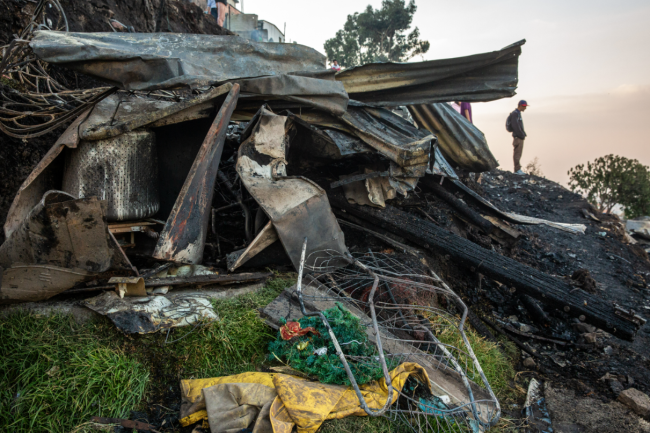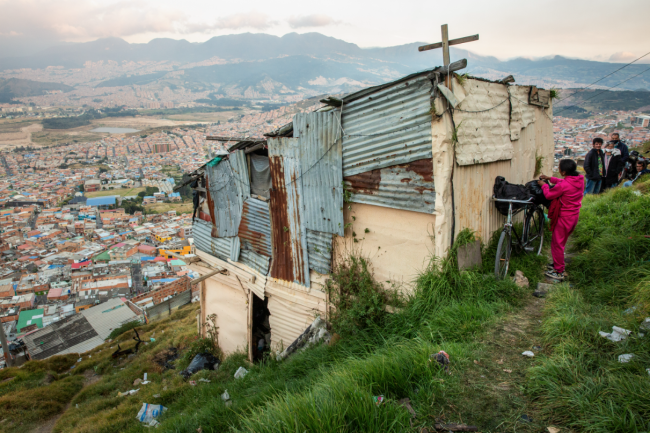
“Don’t worry I will build a better house for you, a house made out of bricks,” said the owner of the house to her son while hugging him, almost in tears, as they looked out at a pile of debris and ashes. Their house in an informal settlement of Ciudad Bolívar, on the outskirts of Bogotá, had just burned to the ground and, according to family members, three of the couple’s children had been inside when the blaze began. “It’s a miracle that my kids didn’t burn as well,” added the mother. At a fast pace, after the fire was under control, they started picking bits of zinc and other materials that did not incinerate completely. This family subsists on the hard work of recycling, a job that is informal in Colombia, generates little income, and is done by some of the most impoverished people in society.
On January 22, multiple wildfires erupted in Colombia's capital city's majestic green mountains. In a recent press conference, Major Carlos Galán said four main wildfires, now under control, affected around 60 hectares. These events, far from isolated, are part of an alarming situation in Colombia and Latin America due to “El Niño”—a climate phenomenon caused by warming waters in the tropical eastern Pacific Ocean—and whose effects are intensified by climate change. The consequences of this phenomenon are not limited to wildfires but have extended to droughts in other Amazon basin countries including Bolivia, Peru, and Brazil.
In the case of Bogotá, all the wildfires that hit the city occurred in districts where informal settlements or marginalized communities are located, making it evident that informal and vulnerable dwellers are the first line at risk of wildfires.
The overall picture of Colombia is also discouraging. So far this year, over 28,000 hectares of vegetation have been affected by wildfires. This is a situation that is expected to continue before the rainy season arrives in March. In response, President Gustavo Petro declared a “situation of disaster and calamity” to redirect funds approved for other purposes towards combating the fires. Petro has also requested international aid and received a positive response from Chile, Peru, Canada, and the United States.
Although the exact origin of the Ciudad Bolívar fire that affected seven houses is unknown, the situation shows the level of exposure faced by those who inhabit informal or marginalized areas on the outskirts of the city. As these families tried to put back their lives together, on the other side of the city residents of El Paraíso, located in the Eastern Hills that circle Bogotá, observed the wildfires approach their neighborhood.
Mass migration from the countryside to Bogotá due to the long-running armed conflict and economic scarcity has contributed to the rapid growth of the city that has extended to the surrounding mountains. It is in these mountains where informal settlements have been established for decades. According to the District Land Registry Administrative Unit, around 35 percent of the houses built between 2012 and 2018 were of informal origin and 256,633 families live in precarious conditions.

Informal settlements commonly rely upon recycled materials such as wood, zinc sheets, plastic, and cartons as building materials. The fact that many of these materials are inflammable, overcrowding, reliance on informal electrical wiring, and the geographic location make these informal dwellings highly susceptible to fires. Local residents face increased risks from the wildfires themselves, the precarious conditions they live in, or a combination of both factors.
“If the fire arrives in the neighborhood, can you imagine how many families would be left on the streets?” asked Jorge Rodríguez, an elderly man who arrived in the neighborhood El Paraíso when he was 10 years old. He remembers there were only a few houses at that time. Now, El Paraíso is a densely populated area. Although this neighborhood is now mostly formalized, the living conditions are often precarious, and some houses are located in fire and flooding risk zones. “What we are experiencing here is a latent danger. Fire and water don’t have boundaries. But fire is what I’m most afraid of,” added Rodríguez, who has improved the conditions of his house little by little over the years. He said he does not like to use wood due to the fire risk it poses, but he had resorted to using this material to reinforce parts of the inside of his house.
Although the flames did not reach the residential area, some neighborhoods such as El Paraíso were on alert over a possible evacuation due to the smoke as the fire burned around 900 meters from the neighborhood's outskirts.
Some residents evacuated voluntarily and sought refuge in the houses of family members, the elderly being the most affected. “Today the smoke has been very strong because the wind is coming down from the mountain,” said Julia Maria Torres, a resident of El Paraíso who relocated her 80-year-old mother to another house made of bricks. The doctor said the smoke was affecting her mother’s lungs. According to Torres, the firefighters recommended covering the holes in her walls with cloth, but her house is made of wooden boards, and it was impossible to prevent the smoke from getting inside. She worries she could lose her house once again; two years ago, her residence burned down due to an electrical fire.
Community Action to Combat the Fires
As the flames intensified, residents of El Paraíso began organizing themselves on their own to control the flames and offer support to those who were actively contributing to firefighting activities. Hydration, food, and recollection points were set up around this steep neighborhood.
While many youngsters and some adults equipped with shovels or machetes climbed the mountains to stop the fire from moving forward, women and children prepared food, coffee, and chocolate for volunteers, soldiers, and firefighters. “Now that our elders don’t have the strength, we, the younger generations, have to fight for those who brought electricity to our neighborhood,” said 26-year-old Jeimy Pinzón Rodríguez whose family has always lived in El Paraíso.

Rodríguez’s family arrived in the neighborhood upon its formation in the 1940s, when a sand and gravel pit located in the area closed down and was divided into lots and sold at low prices. The owners of the pit were the first ones to plant pines and eucalyptuses for its economic potential. Later on, the government at the time initiated reforestation efforts with these species that now predominate in great parts of the surrounding mountains. Pine and eucalyptus, however, are not native to this territory and can in fact contribute to fire propagation. “After this disaster, I just hope the government will replace all those pine and eucalyptus with native species that do not put us at risk,” said Rodríguez. The local government has said that the Botanic Garden will assist the reforestation efforts but did not provide details about what species will be used in this process.
"The expectation that I have is that the government will put people’s lives at the center of its policies because if we don’t have life, we don’t have anything. We are one of the most biodiverse countries in the world and we have to protect our moorlands and our nature,” said Nicol Forero, a member of Plataforma de Juventudes, a network that brings together different youth organizations.
The Eastern Hills of Bogotá are considered cultural patrimony of the city, a sentiment that mobilized people beyond the neighborhoods closest to the fires. During the week that a smoke curtain covered the city, people from all walks of life came together to bring whey beverages, eye drops, masks, and other supplies for volunteers. Help also came for the animals affected by the extreme heat that pounds the city. Members of the youth organization network made drinking troughs with recycled bottles and fed domestic animals and birds. “We want to show that young people are committed to the well-being of the city and don’t just keep on the sidelines looking at what's happening,” said Andres Córdoba, who is part of Plataforma de Juventudes.
“If we talk about hope, in my case this is the last thing I will lose. As a teacher in a marginalized neighborhood, what I see in children is their hope to grow, dream, and become something in life. I believe now many children are saying ‘I want to be a firefighter’ or ‘I want to save birds, save dogs’,” added Forero.
Paula Ximena Henao, director of Bogotá’s firefighters brigade said the fires have been extinguished but new events are expected in February. According to Henao, the brigade is working hand in hand with local residents on a preventive strategy: “Community members are our ambassadors, as is the case of Sumapaz (a moorland that borders the city) where we are training and equipping residents to be the first to respond in the case of a fire.” However, no direct strategy to protect informal and vulnerable dwellers was mentioned during the press conferences.
The alarming situation and the dangers of wildfires to vulnerable and informal settlers have extended to the region of Valparaíso in Chile, where three days of fires have caused the deaths of at least 112 people. According to the mayor of this city, Macarena Ripamonti, “The first neighborhoods to be affected were informal settlements created illegally on the outskirts of the city due to the exposure to trees susceptible to fires.” All these events reinforce the reports by the Intergovernmental Panel on Climate Change (IPCC) that position informal settlers as some of the most exposed to climate change effects including fire, flooding, and extreme temperatures.
Without concrete strategies to prevent wildfires and protect those on the front line of harm, vulnerable communities will continue to suffer disproportionate and life-altering consequences.
Natalia Torres Garzón graduated with an M.Sc. in Globalization and Development at the School of Oriental and African Studies in London, United Kingdom. She is a freelance journalist who focuses on social and political issues in Latin America, especially in connection to Indigenous communities, women, and the environment. Her work has been published in Mongabay, Earth Island, New Internationalist, Toward Freedom, El País, El Salto, Esglobal, and others.
Antonio Cascio is an Italian photojournalist based in Colombia. His work focuses on social movements, environmental justice, discriminated groups, and Indigenous communities. He is a Reuters stringer photographer. His photos have been published in The Guardian, CNN, BBC, DW, Revista 5W, El País, NACLA, Mongabay, Earth Island Journal, Amnesty International, and more. His works have been awarded at the Paris Photo Prize 2023, the IPA, BIFA, and EPA.

